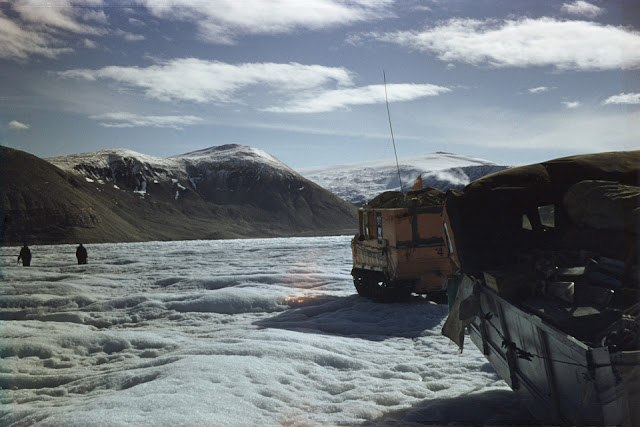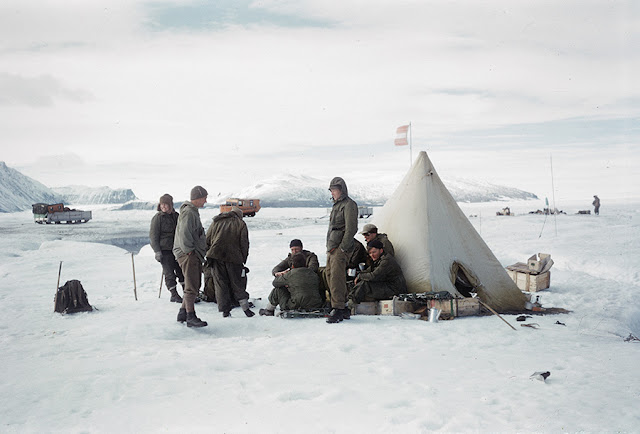The expedition team sailed from Deptford in July 1952 aboard the former Norwegian sealer Tottan. Another cargo ship, loaded with four Weasel tracked vehicles, sailed from Hull, meeting the Tottan in south-west Greenland to collect the expedition's sled dogs. After resupplying, the two ships made for Young Sund on the north-east coast where the expedition met RAF Short Sunderland flying-boats which would airlift them onwards to the glacial lake Britannia Sø. In the following days, Simpson led a dog sled party to establish the North Ice Station about 230 miles to the west. The tracked Weasels were then landed on the coast and after waiting for the sea ice to freeze, drove the 150 miles inland towards the base camp.
Once the rest of party arrived at the site of the North Ice Station on on 16 September, two RAF Handley Page Hastings airdropped 86 tons of equipment and supplies. In preparation for the expedition, the RAF had developed a technique of “free dropping” supplies onto the icecap without parachutes. The supply plane would fly 15 metres over the frozen terrain while the Loadmaster jettisoned crates and supplies from the tail, their angle and height calculated to hit the soft snow, roll, bounce and stop without damage. During a supply operation, one of the Hastings was caught in a white-out blizzard and was forced to make a pancake landing on the ice. Three members of the crew were injured in the crash, and had to take shelter in the intact fuselage of the aircraft, using parachutes for warmth. Three days later an American Grumman HU-16 Albatross arrived to air-lift them out. The rest of the crew who were uninjured were rescued two days later by a rocket assisted USAF Douglas C-47.
In early 1953, the expedition scientists began to conduct glaciological studies, while seismic and gravimetric teams worked in the area between North Ice and Britannia Sø. These observations continued throughout the second winter, and in 1954 a scout party was sent to traverse the ice cap from North Ice to Thule. Here, the party made several failed attempts to measure the thickness of the ice sheet by seismic soundings. Despite this, markers that were placed on the ice enabled information about ice sheet shift and cumulative snow fall to be gathered. Back at North Ice, the remaining team recovered ice cores to a depth of 14 metres from the cap.
As the expedition wore on, The mission became a hazardous one. The narrowest escape of the expedition occurred when two of the Weasels fell into a deep crevasse while headed for Thule. The Weasels were WW2 armoured personnel carriers that had been repurposed for the expedition. They picked over the ice like mountain climbers, roped together for safety. This roping saved the lives of two expedition members when their vehicle plummeted 12 metres into a crevasse before stopping, taking their two fully loaded trailers with them. On the return journey to North Ice, The expedition suffered its only fatality, when Captain H. A. Jensen of the Danish Army, a qualified surveyor, fell to his death on a steep snow slope.
The expedition also studied the harsh effects of the arctic on the human body's performance. One of the outcomes of these experiments was the confirmation that eight hours sleep is on average the amount demanded by the body. In addition to this, the team also had to record the performance of their instruments and before the expedition set out, each member was presented with a Oyster Prince watch, a new release built by Tudor for tough pursuits. It was waterproof, self-winding, and the brand was anxious to prove its credentials. The North Greenland Expedition was the perfect opportunity. It was agreed that team members would log the performance of their watches and return them to Tudor at the end of the expedition for analysis.
After a year, the expedition was re-supplied by both sea and air drop. During the ressupply, eight team members, who had signed on for only one year, left to be replaced by five more. After another year on the ice cap, the expedition returned to England by ship in August 1954. The entire expedition team were awarded the Polar Medal in November 1954, while Commander Simpson was also presented with the Patron's Medal from the Royal Geographical Society in 1955 and was made a Commander of the Order of the British Empire on 2 January 1956.
So, you can probably walk to work when it snows this winter.





No comments:
Post a Comment